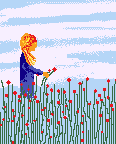■
道場生コラム(その6)
My Endless Mimicry and Continuous Failure:
The Aikido, the Martial Art
Rie Makino

合気道その芸術性ついて
The reason I have continued to practice Aikido for more than ten years simply lies in my philosophy that I consider Aikido art rather than sport. If I thought Aikido was purely an activity to test my physical strength, I would not survive in this field. In other words, the reason for my practice is simple--- I am practicing since I am not adept at performing Aikido. I am practicing since I cannot do what sensei does. I am now starting to recognize an artistic element of Aikido in my continuous failure of mimicking sensei’s waza.
As an individual who has dedicated two thirds of my life to studying literature, I have found a strong similarity between literature and Aikido: mimicry. The primary purpose of practicing Aikido is to replay with different partners, what Takeda sensei does in front of us. I use the term “replay ,” but in this case, “reconstruct” is the best word since practicing Aikido is completely different from playing CDs and videotapes. On the other hand, despite its complexity and profoundness, mimicry is a fundamental part of art. Since human beings cannot recreate the original as it is, what we are doing is not “recreating” but “reconstructing” by tracing the original. Thus, there is an inevitable gap between our mimicry and the original. [※] “Almost the same but not quite” --- a work of art is composed in the process of this mimicry. Literature as the work of art is the result of the continuous dialog among writers living in the past and present. I am also fascinated with the fact that our mimicry, most of the time, ends with failure, and this is, I think, the connection between Aikido and literature.
It is almost impossible to replay what Takeda sensei does in front of us. The most important thing is that we need to have the desire to mimic Takeda sensei. There is, of course, a gap in the skill level between sensei and me; and in this inability and failure to achieve his level of skill, I can see myself. This space is my Aikido, my art.
--------------------------------------------------------------------------------
[※] I borrow this expression from Location of Culture (1994) written by a postcolonial scholar, Homi Bhabha (See page 89); however, I do not mean to compare sensei and our relation to that of colonizer and colonized
(2007年08月16日)
● Home
昔から体育競技が大嫌いで、運動することに無縁であった私が合気道をここまで続けられた理由とは、この武道をスポーツとしてではなく、あくまでも芸術としてとらえていたためではないかと思います。合気道を上手下手、素質があるなしを問うようなものとしてとらえていたならば、おそらく私はこの世界に存在すらしていないでしょう。私がこの武道にひきつけられる理由とはただ一つ-----いつまでたってもうまくならないということです。そしていまやその限りない失敗に一つの芸術性を見出しているのです。
人生の三分の二を文学研究に費した私の観点から見て、合気道はその模倣という行為の中に芸術性が存在すると思います。稽古の目的は武田先生が目の前でなさった技を、日々違った相手とともに、先生がなさるように再生することに主眼があります。再生という言葉をここで使いましたが、再構築のほうがこの場合には妥当であるかもしれません。なぜならこの行為はテープやビデオのような再生とは全く違っているからです。一方芸術には、その重い響きにも関わらず、模倣という行為が根底的な要素の一部としてあります。人間である以上完全なる創造はありえず、以前に存在した何かを頼りに、それを自分なりに再構築していくのが芸術表現です。その際に模倣行為は不完全な人間のなす技であるため、その「原型」である何かとの間にどうしても差異がでてきてしまいます。※「限りなく同じに見えるが違っている」???これの繰り返しが芸術であり、文学作品も究極のところ、この繰り返しの中における小説家同士の対話のようなものであるともいえます。そしてこの模倣が常に失敗に終わるという部分に私は合気道と文学との接点を見出しているのです。
先生が目の前でなさった技を、寸分違わず再現することなどおそらく不可能です。重要なのは失敗するにも関わらず、模倣しようとする意志ではないでしょうか?そしてその限りない模倣の中に残りうる先生と私との差異の中に「私らしさ」がわずかに残っていく。もし現在の私にそのような合気道がとれたなら、それだけで私は幸せに思います。
注釈※
「限りなく同じに見えるが違っている」という言い回しはホミ・ババ(Homi Bhabha)という理論家の「ほとんど同じであるが違っている」という表現を拝借しました。しかしながらババの宗主国の支配者と被支配者と
の関係を合気道の先生と生徒の関係に還元しているわけではないことをここで言及しておきたいと思います。
(2007年08月16日)
● Homeへもどる
(c)合気道清進塾

